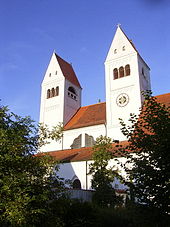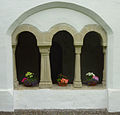Steingaden Monastery
The Steingaden Monastery is a former Premonstratensian Abbey in Steingaden in Bavaria in the Diocese of Augsburg .
history


Since 1055 the area on the upper Lech has played an important role in the Guelph power policy. The castles on the Schlossberg near Peiting and the fortress near Alt-Schongau (Altenstadt) were built to protect it . In 1073 Welf IV. Founded the neighboring Rottenbuch monastery, which quickly rose to become an important Augustinian canon.
The Steingaden Monastery, consecrated to St. Johannes Baptist , was founded in 1147 by Margrave Welf VI. , Son of Duke Heinrich IX. founded by Bavaria , as a Premonstratensian choir monastery and as a house monastery and burial place of the Guelphs . The first canons and the first abbot came from the Premonstratensian Abbey of Rot an der Rot . In 1176 the Romanesque monastery church was consecrated. From 1470 to 1491 the abbey was redesigned in the late Gothic style under Abbot Caspar Suiter. In 1525 it was pillaged and pillaged in the Peasants' War . The destruction in the Thirty Years War was followed by reconstruction under Abbot Augustin Bonenmayr in the style of the beginning baroque until 1663 . From 1740 to 1750 the nave was furnished in rococo .
Another important cultural heritage associated with the Steingaden Monastery is the nearby Wieskirche . It was built from 1745 under Abbot Marinus Mayer and quickly developed into one of the most important pilgrimage churches in Bavaria.
However, the impassable location of this church and the elaborate architectural style brought the abbey into great financial difficulties. The construction costs rose from the originally estimated 39,000 guilders to 180,000 guilders; In addition, there was a further 100,000 guilders for the redesign of the abbey church. Abbot Augustin Bauer finally saw no other way out than to apply to Elector Karl Theodor to abolish the monastery in 1783 , but the latter refused. When Augustine died a year later, Karl Theodor forbade the election of a new abbot. Thus Gilbert Michl for on 24 October 1784 Administrator appointed the monastery. In the following years Michl was able to reduce the debt burden of the monastery significantly, so that the Secret Council approved the election of a new abbot two years later. On November 26, 1786 Gilbert Michl was elected the last abbot of Steingaden.
In the following years he managed to further improve the monastery’s financial situation. However, it remained tense, also because the coalition wars repeatedly led to additional burdens in the form of special taxes, billeting and extortion by soldiers.
Despite the poor financial situation, the monastery could still afford structural investments. For example, under Abbot Gilbert from 1787 to 1790, a 75-meter-long new building for the monastery brewery was built, which was modern for the time and is still preserved today.
The convent and monastery were closed in 1803 in the course of secularization . 1804–1813 the monastery property belonged to the Swiss silk ribbon manufacturer, patron, philanthropist and revolutionary Johann Rudolf Meyer (1739–1813) from Aarau , then his son Johann Rudolf Meyer (1768–1825), one of the first to climb the Jungfrau . The latter sold it back to the Bavarian state in 1816, which turned it into a military foal farm. The monastery buildings were demolished in 1819, except for the wing containing the Romanesque cloister. The monastery property of 213 ha was donated in 1965 by the owner of the parish church foundation Steingaden.
List of provosts and abbots of Steingaden
source
- Anselm, 1147, 1158
- Conrad I., 1170, 1185
- Gebezo, † 1198 (uncertain)
- Walter, until 1202
- Berthold I., 1202
- Gebezo II., 1220, 1226
- Berthold II., 1238, 1263
- Manegold, 1266, 1268
- Heinrich, 1273
- Dietrich, 1286
- Eberhard
- Ulrich I, 1299, 1312
- Berthold III., 1341
- Berthold IV., 1361, 1362
- Johann I.
- Conrad II.
- Ulrich II.
- Peter
- Johann II. Sürg von Sürgenstein, 1399, † 1431
- Johann III. Scheytterer, 1431–1445 (abbot from 1434)
- Johann III. Scheytterer, 1434-1445
- Johann IV. Pfeiffer, 1445-1450
- Conrad III. Vischer, 1450-1456
- Caspar Suiter, 1456-1491; received the pontificals in 1475
- Vitus Maier, 1491–1500
- Ulrich III. Semolina bag, 1501-1523
- Johann V. Dimpt, 1523-1535
- Michael Moser, 1535–1553
- Joachim Wiedemann (Salicetus), 1553–1580
- Gallsu Theininger, 1580-1606
- Georg Frühschutz, 1606–1623
- Norbert Marstaller, 1623-1645
- Augustin I. Bonenmayr, 1645–1674
- Gilbert I. Schmid von Wellenstein, 1674–1684
- Hieronymus Hail, 1684–1687
- Augustin II. Baur, 1687–1699
- Marian I. Bichele, 1699-1708
- Anton Erath von Erathsburg, 1708–1715
- Magnus Pracht, 1715-1729
- Hyacinth Gassner, 1729-1745
- Marian II. Mayr, 1745-1772
- Gregor Fischer, 1772–1774
- Franz Weber, 1774–1777
- Augustine III Bauer, 1777–1784
- Gilbert Michl, 1786–1803, † 1828
Monastery complex
Monastery church
The monastery church of St. Johann Baptist, also called Welfenmünster , is now the parish church of Steingaden .
Cloister
Of the convent buildings, only the west wing (today the rectory) survived the secularization. The two-story building contains the last remaining remains of the former cloister on its ground floor . The nine Romanesque bays were vaulted in the late Gothic. To the outside, the cloister opens into seven three-part and two two-part arcades , which are still framed by baroque blind arches. The column capitals show different ornaments, such as rosettes and foliage. On the sixth yoke, the well chapel jumps out of the flight of the wall, which was dedicated to the holy New Year's Eve. The walls are decorated with late Gothic frescoes depicting the crucifixion, scenes from the life of St. New Year's Eve, the handkerchief of St. Veronica and others. The late Gothic vault shows the rich network configuration of the cloister yokes.
graveyard
In the cemetery is the grave of Dominikus Zimmermann , the builder of the Wieskirche .
Johanneskapelle
According to tradition, the Romanesque rotunda was built on regular sandstone blocks around 1154 by order of Duke Welf VI. erected and commemorates the Church of the Holy Sepulcher in Jerusalem. Under Abbot Ulrich III. Griespeitel (1501–1523) is said to have been moved to its current location next to the west entrance of the cemetery. The keystone of the net vault is marked "1511". Outside, only the Gothic pointed arch window on the east side indicates this reconstruction. The high medieval structure consists of wall templates with half-columns, the capitals of which support a round arch frieze. A tooth-cutting tape runs around the building. The west side has been covered by a gatehouse since 1589. The arched north portal still has its old tympanum relief with the half-length figures of the Savior between Mary and John. To the left of the portal, two lion reliefs have been inserted into the masonry.
After secularization , the sacred space had to serve as a wooden frame. In 1845, Count Eckbrecht von Dürckheim-Montmartin acquired the chapel in order to have it converted into a family crypt from 1853 , in which Karlfried Graf Dürckheim is also buried. The neo-Romanesque stone altar is a creation by Ludwig Foltz the Elder. J. (1853), the death shield hanging on the west wall dates from the 20th century.
Monastery museum
The monastery museum is located in the vicarage in the former pharmacy wing of the monastery, directly adjacent to the monastery church .
See also
Web links
- Steingaden Monastery , basic data in the database of monasteries in Bavaria in the House of Bavarian History
literature
- Sigfrid Hofmann: Steingaden Monastery 1147–1803. (Schongau 1947.)
- Historic Steingaden: On monastic paths (PDF; 4.1 MB)
Individual evidence
- ↑ Hans-Josef Bösl: Gilbert Michl (1750-1828), the last abbot of Steingaden - A life between the Enlightenment and secularization. In: Sankt Barbara Abensberg - How it was and is. Abensberg 2005, pp. 39-68.
- ↑ Historisches Steingaden: On Monastic Paths ( Memento of the original from September 28, 2015 in the Internet Archive ) Info: The archive link was inserted automatically and has not yet been checked. Please check the original and archive link according to the instructions and then remove this notice. (PDF; 4.1 MB), p. 22.
- ↑ Joachim Wild: The Premonstratensian Canons of Steingaden in the year of secularization 1803. In: Der Welf, Yearbook of the Historisches Verein Schongau, 2006 f., Pp. 143–154.
- ↑ Peter Genner: From Aarau to Bavaria. Emigration and decline of the Meyer entrepreneurial family. In: Aarauer Neujahrsblätter, 2011, pp. 36–69, 2012, pp. 97–143. Peter Genner: After the rule of the monastery - Swiss revolutionaries in the Pfaffenwinkel. In: Der Welf, Yearbook of the Historical Association Schongau, 2013, pp. 69–192 ( digitized version ). Peter Genner: Johann Rudolf Meyer son (1768–1825) and the Meyer family. Website IG Meyersche Stollen, Aarau 2015 ( digitized version ).
- ↑ Michael Hartig: Die Oberbayerischen Stifts , Volume II: The Premonstratensian Monasteries, the Altomünster and Altenhohenau Monasteries, the Collegiate Monasteries, the Order of German and the Order of Malta, the post-medieval wealthy medals and pens . Publisher vorm. G. J. Manz, Munich 1935, DNB 560552157 , p. 27.
- ^ Community Steingaden: Monastery museum in the rectory . Retrieved June 4, 2014.
Coordinates: 47 ° 42 ′ 4.7 ″ N , 10 ° 51 ′ 45 ″ E







